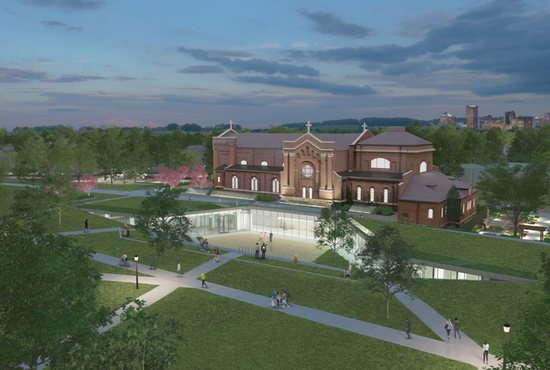
Standing sentinel before the century-old Chapel of St. Thomas Aquinas in St. Paul are an array of earthmovers and an enormous drill poised for use.
For the University of St. Thomas, these are reminders that soon the landscape surrounding the chapel will have changed dramatically — in many places, from grass to glass.
In November, the university unveiled its plans to expand the red-brick chapel and add a new faith center. Rather than add a substantial addition above ground, the design leverages the chapel’s position on a hill and adds space to the north and west, mostly below the current ground level.
The official groundbreaking for the $12.7 million, 23,000-square-foot project was to be held May 2. Named the Iversen Center for Faith for benefactors Al and Brenda Iversen, the new space includes rooms for wedding parties’ preparation, bathrooms, a sacred art gallery, campus ministry office space, a multi-faith prayer room, banquet space and kitchen. It also improves the chapel’s wheelchair accessibility.
Also planned are a new plaza in front of the chapel and an outdoor amphitheater that faces the campus’ upper quadrangle, home to several large dormitories. The project is expected to be completed in spring 2020.
The design incorporates a significant use of glass — around the new building’s entrances, along corridors and in skylights. That will not only allow sunlight into the building during the day, but is also expected to light the existing church in a striking way at night — creating what Victoria Young, the chair of St. Thomas’ art history department and a member of the project’s planning team, called a “light-box pedestal” around the church.
Meanwhile, the chapel will receive renovations such as air conditioning and improved lighting, amenities expected and long overdue in a building that gets so much use — not only by students, but also alumni, Young said, noting the numerous weddings and funerals held there annually.
Archbishop John Ireland commissioned the chapel, which was completed in 1919. It was designed by E.L. Masqueray, the French architect who also designed the Cathedral of St. Paul in St. Paul and the Basilica of St. Mary in Minneapolis.
With the expansion, “we’re making a commitment to having this being here for another 100 years, to sustain the vision of Masqueray and Ireland,” Young said of the chapel. “It has to be the spiritual heart of campus.”
Creating a design that complemented but didn’t compete with the chapel was a challenge, said Ernesto Ruiz-Garcia, who designed the project while at The Opus Group, the Minneapolis company building the project. That’s why his team put the expansion underground. He said that creating a “meaningful sense of arrival” for visitors was especially important.
“What I’m hoping this does is that it’s transformative for the campus,” said Ruiz-Garcia, who now works for Alliance, another Minneapolis design firm. “There’s a lot of sense that this building will be good for the campus. … I really can’t wait to see it.”
Between 40 and 45 percent of St. Thomas’ undergraduates have self-identified as Catholic in university surveys, said Vineeta Sawkar, the university’s senior media relations manager, noting that the actual number of Catholics may be higher.
Most people on campus profess a faith, Young said, and the chapel expansion aims to make a dedicated space for religious diversity, “finding the common good that comes from all these different faiths being together.”
That’s demonstrated in the planned multi-faith prayer room, which is designed to be used not only by Christian groups on campus, but also non-Christian students.
Father Larry Blake, director of campus ministry and university chaplain, said the Center for Faith provides new opportunities for campus ministry programming and connecting his team with students, especially because the center will link to adjacent dormitories.
“Walking through it, they’ll (students) be able to see what we have going on there,” he said. “I do think it will allow us to be in contact with a wide range of students from diverse backgrounds. I’m very excited for this project to get underway.”



